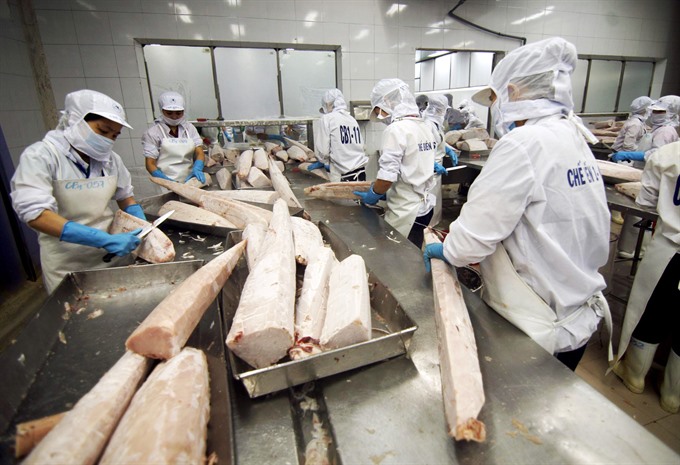 Economy
Economy

The first meeting of the Comprehensive and Progressive Agreement for Trans-Pacific Partnership (CPTPP) Commission ended in Tokyo, Japan, on Saturday with a joint statement adopted by ministers in charge of economy and trade from 10 member nations.
 |
| Processing tuna in Bình Định Fishery JSC. Việt Nam’s export of seafood is expected to grow further after CPTPP takes effect. — VMA/VNS Photo Vũ Sinh |
TOKYO — The first meeting of the Comprehensive and Progressive Agreement for Trans-Pacific Partnership (CPTPP) Commission ended in Tokyo, Japan, on Saturday with a joint statement adopted by ministers in charge of economy and trade from 11 member nations.
The joint statement affirmed their determination to fully enforce the CPTPP in support of trade liberalisation, setting high and fair standards for trade as well as fostering economic growth and bringing benefits to both people and enterprises.
They also approved four decisions, covering the CPTPP Commission’s operation mechanism; the process for admission of new members; the process of the arbitral tribunal related to state-to-state settlement of disputes; and a code of conduct for arbitrators related to the settlement of disputes between an investor and a state.
In his opening remarks, Japanese Prime Minister Shinzo Abe affirmed the member economies are determined to do their utmost to ensure the CPTPP plays a leading role in trade liberalisation amid rising protectionism.
He said the CPTPP remains open for any nation and territory that wants to join.
In an interview with Vietnam News Agency (VNA) correspondents in Tokyo, Vietnamese Minister of Industry and Trade Trần Tuấn Anh said commitments are being implemented in an active, serious and full manner in the initial phase thanks to the thorough preparations of member states.
He voiced his belief they will enforce the agreement effectively to bring benefits to both people and enterprises.
According to him, the three challenges facing Việt Nam are pressure during the enforcement process; increasing competitiveness in not only goods but also services; and measures to bring into full play opportunities brought by the CPTPP.
Export opportunities
Koichi Ishikawa, a professor from the Institute of Asian Studies under the Asia University, said the deal will help increase Việt Nam’s exports of garments and textiles, footwear, farm produce, seafood and food.
He cited estimations by US experts that foreign trade of the 11 member states of CPTPP would increase 11.5 per cent while foreign investment would rise 3.5 per cent by 2030. In particular, Việt Nam would be the biggest beneficiary with growth of foreign trade and investment expected at respectively 30.1 per cent and 14.4 per cent.
The total gross domestic product (GDP) of the CPTPP countries exceeds US$10 trillion, nearly equal to China’s GDP, while import turnover is estimated at $2.33 trillion, surpassing both China and ASEAN’s figures.
Ishikawa reckons these numbers will be higher if more countries join the pact.
Concerning bilateral free trade agreements (FTAs) between CPTPP members, Japanese professor said there were no contradicting benefits between FTAs and CPTPP as FTAs have different lists of goods, rates of tariff preferences and rules on product origin.
From enterprises’ perspective, they would exploit FTAs that bring the biggest benefits for them, Ishikawa said.
The CPTPP is expected to help Việt Nam expand exports to both countries without bilateral FTAs with Việt Nam, such as Canada, Mexico and Peru, and countries that already have trade deals with Việt Nam, he said.
However, he also pointed out the weakness in Việt Nam’s supporting industry as the country is still heavily dependent on imported machinery and equipment.
According to the data compiled by Japanese organisations, up to 58.1 per cent of Japanese enterprises in Việt Nam indicated they had difficulties finding materials and spare parts locally. — VNS




